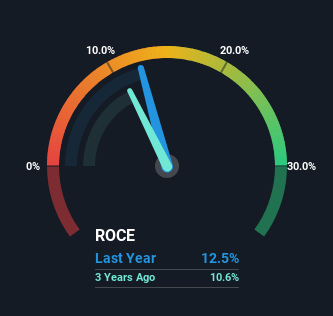- Netherlands
- /
- Chemicals
- /
- ENXTAM:AKZA
Akzo Nobel (AMS:AKZA) Is Doing The Right Things To Multiply Its Share Price

What trends should we look for it we want to identify stocks that can multiply in value over the long term? Typically, we'll want to notice a trend of growing return on capital employed (ROCE) and alongside that, an expanding base of capital employed. Put simply, these types of businesses are compounding machines, meaning they are continually reinvesting their earnings at ever-higher rates of return. Speaking of which, we noticed some great changes in Akzo Nobel's (AMS:AKZA) returns on capital, so let's have a look.
Understanding Return On Capital Employed (ROCE)
If you haven't worked with ROCE before, it measures the 'return' (pre-tax profit) a company generates from capital employed in its business. Analysts use this formula to calculate it for Akzo Nobel:
Return on Capital Employed = Earnings Before Interest and Tax (EBIT) ÷ (Total Assets - Current Liabilities)
0.13 = €1.1b ÷ (€14b - €5.2b) (Based on the trailing twelve months to March 2024).
Thus, Akzo Nobel has an ROCE of 13%. In absolute terms, that's a pretty normal return, and it's somewhat close to the Chemicals industry average of 11%.
See our latest analysis for Akzo Nobel

Above you can see how the current ROCE for Akzo Nobel compares to its prior returns on capital, but there's only so much you can tell from the past. If you're interested, you can view the analysts predictions in our free analyst report for Akzo Nobel .
What Does the ROCE Trend For Akzo Nobel Tell Us?
You'd find it hard not to be impressed with the ROCE trend at Akzo Nobel. We found that the returns on capital employed over the last five years have risen by 146%. The company is now earning €0.1 per dollar of capital employed. Speaking of capital employed, the company is actually utilizing 25% less than it was five years ago, which can be indicative of a business that's improving its efficiency. Akzo Nobel may be selling some assets so it's worth investigating if the business has plans for future investments to increase returns further still.
For the record though, there was a noticeable increase in the company's current liabilities over the period, so we would attribute some of the ROCE growth to that. The current liabilities has increased to 36% of total assets, so the business is now more funded by the likes of its suppliers or short-term creditors. It's worth keeping an eye on this because as the percentage of current liabilities to total assets increases, some aspects of risk also increase.
Our Take On Akzo Nobel's ROCE
In summary, it's great to see that Akzo Nobel has been able to turn things around and earn higher returns on lower amounts of capital. And since the stock has fallen 12% over the last five years, there might be an opportunity here. With that in mind, we believe the promising trends warrant this stock for further investigation.
If you want to know some of the risks facing Akzo Nobel we've found 2 warning signs (1 makes us a bit uncomfortable!) that you should be aware of before investing here.
While Akzo Nobel may not currently earn the highest returns, we've compiled a list of companies that currently earn more than 25% return on equity. Check out this free list here.
If you're looking to trade Akzo Nobel, open an account with the lowest-cost platform trusted by professionals, Interactive Brokers.
With clients in over 200 countries and territories, and access to 160 markets, IBKR lets you trade stocks, options, futures, forex, bonds and funds from a single integrated account.
Enjoy no hidden fees, no account minimums, and FX conversion rates as low as 0.03%, far better than what most brokers offer.
Sponsored ContentNew: Manage All Your Stock Portfolios in One Place
We've created the ultimate portfolio companion for stock investors, and it's free.
• Connect an unlimited number of Portfolios and see your total in one currency
• Be alerted to new Warning Signs or Risks via email or mobile
• Track the Fair Value of your stocks
Have feedback on this article? Concerned about the content? Get in touch with us directly. Alternatively, email editorial-team (at) simplywallst.com.
This article by Simply Wall St is general in nature. We provide commentary based on historical data and analyst forecasts only using an unbiased methodology and our articles are not intended to be financial advice. It does not constitute a recommendation to buy or sell any stock, and does not take account of your objectives, or your financial situation. We aim to bring you long-term focused analysis driven by fundamental data. Note that our analysis may not factor in the latest price-sensitive company announcements or qualitative material. Simply Wall St has no position in any stocks mentioned.
About ENXTAM:AKZA
Good value average dividend payer.
Similar Companies
Market Insights
Community Narratives



